page 15
~ The Study of Threes ~
http://threesology.org
| Hybrids page 1 | Hybrids page 2 | Hybrids page 3 | Hybrids page 4 | Hybrids page 5 |
| Hybrids page 6 | Hybrids page 7 | Hybrids page 8 | Hybrids page 9 | Hybrids page 10 |
| Hybrids page 11 | Hybrids page 12 Playmate God |
Hybrids 13 Economics 1 |
Hybrids 14 Economics 2 |
Hybrids 15 Economics 3 |
| Hybrids 16 Economics 4 |
Hybrids 17 Economics 5 |
Hybrids 18 Economics 6 |
Hybrids 19 Economics 7 |
Hybrids 20 Language 1 |
| Hybrids 21 Language 2 |
Hybrids 22 Language 3 |
Hybrids 23 Language 4 |
Hybrids 24 Physics |
Hybrids 25 |
| Hybrids 26 | Hybrid 27 |
Visitors as of 30th July, 2021

We do not customarily think of Economics as a type of husbandry because we do not think of humans as part of the domesticated animals used for different reasons, though if we look at the different occupations, many of which are labor-related, we must indeed look at humans as part of the equation and that economics needs to be viewed as a type of husbandry. With this said:
Adverse effects of livestock on the environment are caused by the way animal husbandry is practiced, in no small part because animals are not integrated with other agricultural and forestry-based practices. (Integrating Animal Husbandry With Crops and Trees, by Rattan Lal')
When we speak of domesticating animals, it is necessary to note that humans form a large group that requires domestication in the form of education, establishing moral boundaries, establishing laws, establishing laws, holiday and other celebratory observances and a police as well as armed forces. However, the number of incarcerated individuals tells us that the program of domestication is not always successful. Neither does domestication create a means to domesticate legislatures, religions and businesses from causing harm to the public. Music, alcohol and other substances are frequently used as a means to provide a person with an excuse why they acted like an undomesticated wild person. In fact, we might say that recurring diseases are the result of the kind(s) 0f domestication programs and other practices human engage in. Poverty may be a disease created by the type(s) 0f domestication people practice due to the business, political and religious beliefs.
With respect to horses for example, all horse breeds are classified into three main groups: heavy horses, light horses, and ponies. (Horses and Ponies). With respect to horse racing in particular, all modern Thoroughbreds trace back to three stallions imported into England from the Middle East in the late 17th and early 18th centuries: the Byerley Turk (1680s), the Darley Arabian (1704), and the Godolphin Arabian (1729) (sometimes referred to as Godophin Barb). (Thoroughbred); (The History of the Godolphin Barb).
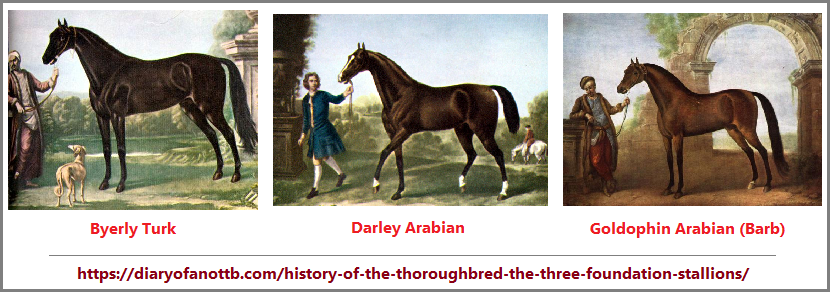
Interestingly, when correlating this "three" development with humanity (viewed as a breed of animals), it was at one time considered that humanity had three breeds denoted as African- Asian- Caucasian (or Caucasoid, Mongoloid, Africanoid), just as we sometimes encounter the reference of three main crops for world consumption (rice, wheat, corn) and may metaphorically (alternatively) describe them as basic, foundation, or original races; so as to establish some correlation with other "three" referenced items which are expressed in terms of fundamentals. In other words, Economics is a type of physics, and mathematics, and biology, an music, and multiple other subjects which look at fundamentals; though such a term (along with the term "metrics") is most duly noted in conversations about stocks.
- What Are the Fundamentals of a Stock?
- A stock's fundamentals are the factors that are thought to contribute to the underlying company's value or worth as a business. Fundamentals can include measurable, quantitative data (like cash flow and debt-to-equity ratio) and qualitative, situational factors (like business model and competitive advantage).
- Fundamental Analysis by Troy Segal, Updated September 09, 2021 Fundamental analysis (FA) is a method of measuring a security's intrinsic value by examining related economic and financial factors. Fundamental analysts study anything that can affect the security's value, from macroeconomic factors such as the state of the economy and industry conditions to micro-economic factors like the effectiveness of the company's management. The end goal is to arrive at a number that an investor can compare with a security's current price in order to see whether the security is undervalued or overvalued. This method of stock analysis is considered to be in contrast to technical analysis, which forecasts the direction of prices through an analysis of historical market data such as price and volume.
- How to Pick Stocks Using
Fundamental and Technical Analysis by Lee Bohl and Randy Frederick
- Fundamental analysis attempts to identify stocks offering strong growth potential at a good price by examining the underlying company’s business, as well as conditions within its industry or in the broader economy. Investors have traditionally used fundamental analysis for longer-term trades, relying on metrics such as earnings per share, price-to-earnings ratio, price-to-earnings growth, and dividend yield.
- Technical analysis, on the other hand, bypasses the underlying company’s fundamentals and instead looks for statistical patterns on stock charts that might foretell future price and volume moves. The idea here is that stock prices already reflect all the publicly available information about a particular company, so there’s nothing to be gained from poring over a balance sheet. Given the focus on price and volume moves, traders have traditionally used technical analysis for shorter-term trades... But does it have to be an either/or proposition?...
Hence, we can identify the presence of a fundamental or standard or staple cognitive pattern being used in economics (though a quick survey reveals economics to garner a heavy interest in the use of dichotomous orientations, and less interest in singular, triple or multiple options), just as we can define a standard cognitive model when correlating a fundamental pattern of anatomy with the three traditionally viewed social divisions of lower class- middle class and upper class:
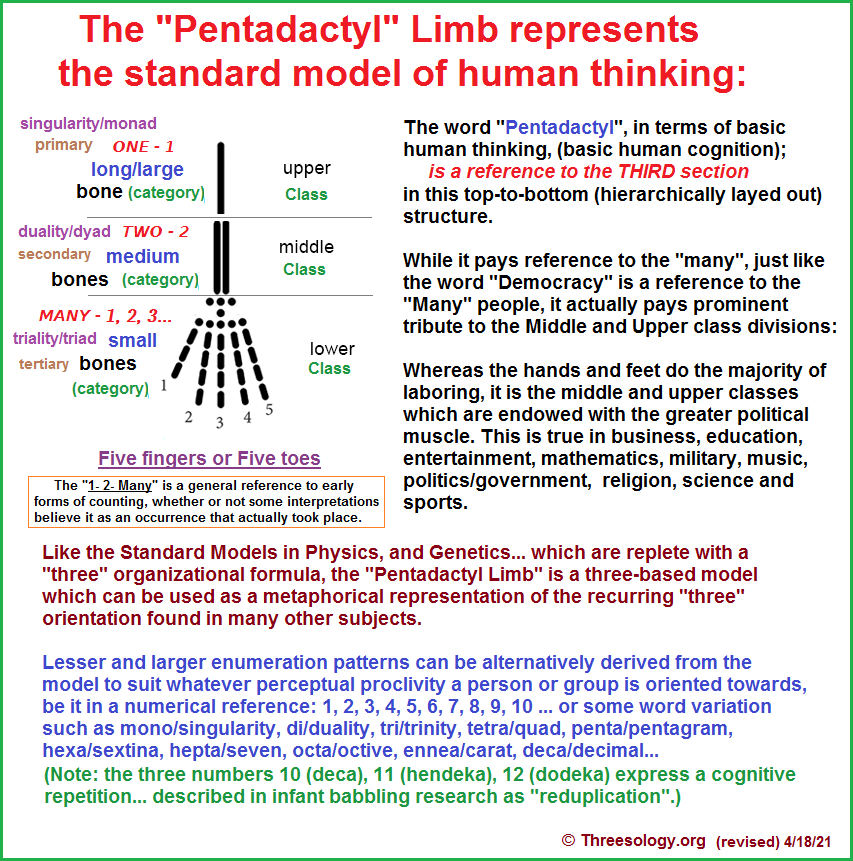
Standard Cognitive Model
Whereas there are three "original" or fundamental races of humanity provided by some accounts as the bases for the human population, later accounts supply other groups as being "fundamental", such as the Native American and Native Australian, though other viewers claim these two as sub-groups of one or more of the previous three.

With respect to staple plant foods, one might alternatively choose to a different three-based grouping system, though alternatives exist. (Staple food:)
- Cereals (such as rice, wheat, maize, millet, and sorghum)
- Starchy tubers or Toot vegetables (such as potatoes, cassava, sweet potatoes, yams, or taro)
- Dried legumes (such as lentils and other beans)
Interestingly, most plants are divided into moncot or dichot, and yet a trichot plant is not unheard of: (Monocot, Dichot, Tricot?) The reason for including the plant distinctions, though one might use other biological references such as the three main parts of seeds, is to introduce the recurrence of a basic "system" of patterning that Economics is fully embedded in, and yet appears to intellectually express a predominant orientation for using two-patterned ideas instead of available alternatives as descriptively illustrated by evolutionary changes along a fundamental 1, 2, 3 developmental sequence. It appears to use a two-patterned yin/yang formulation such as dividing so much of its underlying features into dichotomies. Two examples of which are "either/or propositions" (stocks) and "Market noise/Market news", though multiple others exist.
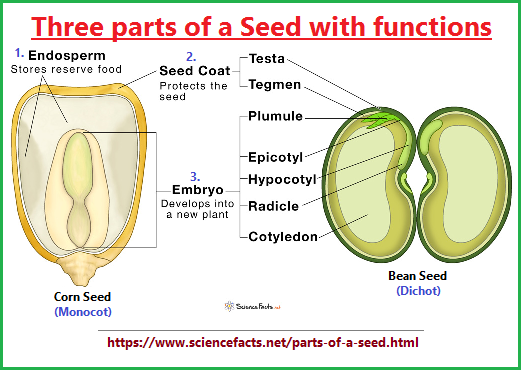
The presence of a philosophy which is dominated by dichotomous thinking is indeed a problematic situation... because the practice of Economics, if permitted to retain an out-dated orientation, will forcibly attempt to maintain its survival level of equilibrium and not permit society to evolve. It is also problematic when we see such a philosophy as a "diversified portfolio" which would appear to some as an expression of evolution in that we move from single market shares expressed metaphorically as herbivores (Plant eaters) and carnivores (Meat eaters) to omnivores (Multi-food groups eaters), and yet the underlying reason for such a labeled move is not diversification but a focus on a singular orientation. For example, a company splits into two or more companies or divisions so that each can focus on a singular aspect (which may or may not consist of multiple products in a given category); like a multi-headed or multi-limbed life form. Just because a company "diversifies" into another limb does not mean the company is actually practicing a strategy of multi-talents that some observers might equate with a non-discriminatory policy; and yet such a focus is indeed is singular.
The usage of terms and ideas from other subjects to give the impression for a desired growth in Economics thinking is undercut when such terms are masks... are a camouflage... are a subterfuge for using an outdated two-patterned philosophy which has been re-packaged with the ideological trimmings of a given era's cultural orientations, which very often engage in altering the superficialities of a perspective originating in a past era and is attached with some type of irrevocable acceptance crafted according to the social tastes of a given time period in history. Holding on to such a philosophy and wanting everyone to agree with such a perspective (albeit with the language of a given subject such as biology or physics or mathematics as is being used in a given era); also expects society to maintain a structure and function which will permit such a philosophy to maintain the larger market share of the public's dependency on it, and not allow it to prosper along a more ideally suited evolutionary pathway. In other words, the insistence of economists using a preference for two-patterned orientations is like those who have learned how to profit from and maintain a large portion of a public's support for insisting that the yin/yang idea is a fundamental construct of nature, and not a nature of the human psyche exhibiting an ability for making progressive transitional changes if permitted to complete its assertions for doing so during fledgling developmental attempts to step beyond such traditions.
The so-called laws of nature and recurring biological, geological, physic's, table of basic elements, DNA's triplet code, etc., standards identified by humans and placed into various categories, are exhibitions of economics we might otherwise describe as conservations. (Conservations developed in response to an incrementally deteriorating environment.) From our human perspective, the categories we are coming up with, describe the types of economics employed by nature to take advantage of resources in particularized domains... which have also been seen in the usage of a three domains of life idea. However, we should not be foolishly presumptuous into thinking that Nature has "cornered the market" so-to-speak on which brand of economics is best suited... though "best suited" may be referenced differently, such as being best suited in a selfish way for a specific domain, but not best suited for the overall survival of all life forms, or most or a specific species specifically beneficial to humanity's existence. It is foolish also to think that nature was developed for humans and all the things of nature are what's best for human existence and growth. Then again, "growth" can be viewed from a perspective related to an existence on Earth, or elsewhere in the Universe... whereby the resources of Earth are merely throw-away commodities useful for a time while humans are on Earth.
With respect to the development of categories used in science and elsewhere, when I say "coming up with", I mean it along the same lines as a child who (seemingly) arbitrarily chooses one color over another from a crayon box. Depending on the size of the box which may offer different quantitative assortments of colors (color combinations); that which is defined by one or another label is like a scientist who may be working with a few or multiple bits of information and decides very often by educated or experienced guesswork which type of categorization best fits the information at hand. Indeed, the category of thinking which labels humanity as being in the image of any god, may be little more than that derived from information related to the human ego. No less, the biblical statement which categorically claims that:
Genesis 9:2, NIV: "The fear and dread of you will fall on all the beasts of the earth, and on all the birds in the sky, on every creature that moves along the ground, and on all the fish in the sea; they are given into your hands." (Genesis 9:2 Parallel Verses)
This is a foolish economics philosophy. In fact, so much for humanity "being one with nature" or cherishing and promoting the human capacity for love, kindness, and generosity. While religious texts purport to be a message between some supposed divine being and humanity and offering what is best, we find that it is lousy philosophy, lousy history, lousy mathematics, lousy architecture, lousy linguistics, lousy law, lousy physics, lousy music, lousy economics and only valuable in the context of reading them as the compilations of ideas created by delusional neurotics and psychotics. And because so many subjects project ideas which are contradictory, it's no wonder we have a world of delusional neurotics and psychotics.
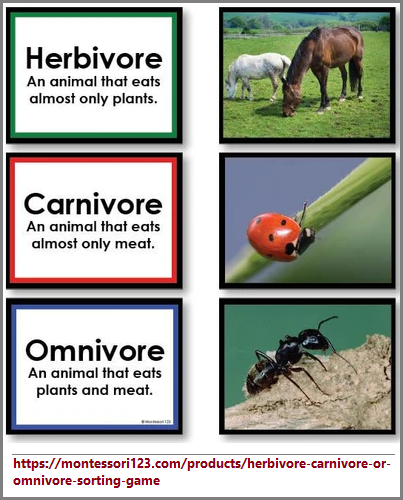
While the descriptions of Carnivore, Herbivore, and Omnivore are most often assigned to the description of the dietary habits of animals, we can also find these categories used to describe the eating habits of plants. Hence, we have three economies of eating.
| Herbivore | Carnivore | Omnivore |
| Grazing animals | Lions, Tigers, etc... | Humans |
| Mistletoe | Venus Fly Trap | Bladderworts |
- Herbivore plants: Parasitic Plants Have a Surprising Accomplice, by Jennifer Frazer on August 15, 2018
- Carnivorous plants: Carnivorous plant
- Omnivorous plants: Even Plants Eat Their Greens by Ashok Prasad, September 15, 2008
While some readers might consider the Omnivorous diet to be synonymous with having a diversified... and therefore evolved investment portfolio, they overlook that such a rapacious ability is also the more aggressive in terms of taking advantage of all resources, despite the acts of murder/survival meat eaters engage in. Herbivores are not looked upon as aggressors, though in fact they are and do themselves engage in the murder of plants. Just like some plants which kill insects. Hence, while some view the activity of investing in a wide (omnivorous) spectrum to be more intelligent and wise, they overlook the activity as being more aggressive, thus providing us with a tell-tale sign that economic strategies are becoming more prone to using ever-increasing aggressive tactics as a survival mechanism which will have to adapt to depleting stores of resources coupled to an incrementally deteriorating planetary system's environment.
And though this page is about Economics, one need not speak to the obvious concerning the economic advantages or disadvantages that arise when using a "three" or triple-based model of categorization. If we think about economics as an exercise in the maximization of conservation (since this philosophy will play out as the eventual dominating theoretical base), we can view the same "three" (conservative) usage in multiple human spheres such as:
- Particle physics (Protons- Neutrons- Electrons)
- Genetics (A triplet code in DNA)
- Three University degrees (PhD, Masters, Bachelors)
- In ending a sentence (period- question mark- exclamation point)
- Many vending machines in the US of A: (nickels-dimes-quarters)
- and many other economically applicable criteria;
While learning how to contrast the "three" with the presence of multiple dichotomies (or "twos")... which needs to be reference as a recurrence, for those who are interested in making sense of patterns.
Indeed let us not fail to include the three "founding" life forms now recognized in the Tree of Life concept:
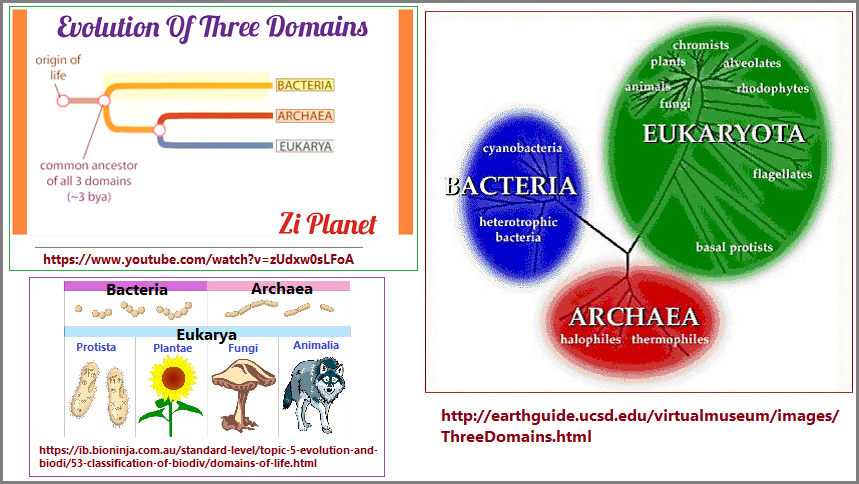
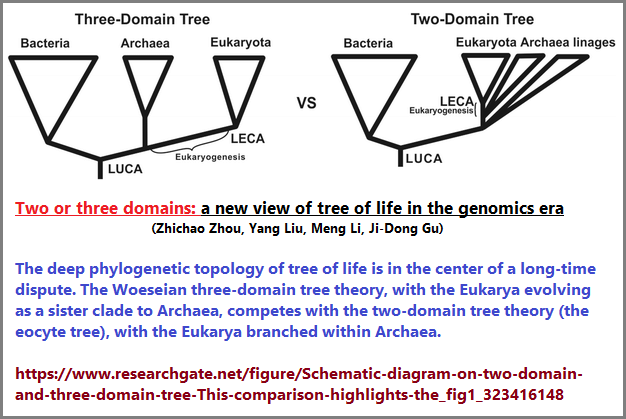
- Only certain animals, including dogs, cats, pigs, horses, sheep, goats, chickens, and cows, have been successfully domesticated all over the world.
Why Can't Every Animal Be a Pet?... Experts believe that animals must meet six
criteria in order to be domesticated successfully:
- Domestic animals must be able to find sufficient food near human settlements.
- Domestic animals must mature quickly.
- Domestic animals must be able to reproduce in captivity.
- Domestic animals need to be gentle by nature.
- Domestic animals must not have strong flight tendencies.
- Domestic animals must conform to a social structure that recognizes a strong leader. With the exception of cats, most all domesticated animals are willing to recognize a human caretaker as their leader.
- Why do we consume only a tiny fraction
of the world's edible plants? by John Warren
- Scientists estimate that there are more than 400,000 species of plants on earth, at least half of which are edible for humans. Indeed, it is entirely possible that we are capable of eating 300,000 plant species. And yet we consume just a tiny fraction of that. Homo sapiens, the most cosmopolitan of species, one that thrives by virtue of being a generalist, eats only about 200 plant species. Remarkably, a mere three crops – maize, rice, and wheat – account for more than half of the calories and proteins that we derive from plants.
- Cereal, Grasses, and Grains
- Staple Food:
- Just 15 plant crops provide 90 percent of the world's food energy intake (exclusive of meat), with rice, maize, and wheat comprising 2/3 of human food consumption. These three are the staples of about 80 percent of the world population, and rice feeds almost half of humanity
Indeed, if we look at the paltry sum of all the worlds plants humans use for the majority of foodstuffs, we need also take into consideration of the fact that the human body uses three basic sources from which to derive energy for nutrition: They are Carbohydrates, Fats, Proteins. In other words, nature is involved with developing a conserved means by which humans can survive... suggesting that Economics is such a measure as well, and must be further determined whether Economics is at present a domesticated variety of conceptualization or is a wild type... or perhaps in some traditionary mode such as being part domesticated but retains a wild side, seed, or strain. Planet-wide, there are water, sunlight and air as three features of different economic orientations as well as Nature-born acts of conservation. And if we look at the type of political systems being practiced which went along with cultivation, we come upon a scenario in which three types have been identified:
...Early states formed in piecemeal fashion, the authors argue. These political systems incorporated one or more of three basic elements of domination:
- Violent control of the masses by authorities (Using various heavy-handed techniques typically in the form of paid killers or would-be inflictors of severe punishment)
- bureaucratic management of special knowledge and information (such as by way of soothsayers, a priestly class, astronomers, etc...)
- public demonstrations of rulers' power and charisma.
'The Dawn of Everything' rewrites 40,000 years of human history
Today, the control of the masses uses various methods of financial control, which can come about through war, public policies, hearth concerns, claimed terrorist activities, etc... And yet, here too we see only a few techniques being used, much in the manner in which weather occurs. In other words, we do not see multiple types of weather hybridizations taking place.
So too might we include Georges Dumezil's Trifunctional Hypothesis view of Indo-European cultures as a cognitively expressed conservation representing different interactive models of economics (or a 3-in-1 ratio), just as the three branches (Executive, Legislative, Judicial) of the US government express different economically-oriented functions that we also see in the old Master- Journeyman- Apprentice guild sequence.
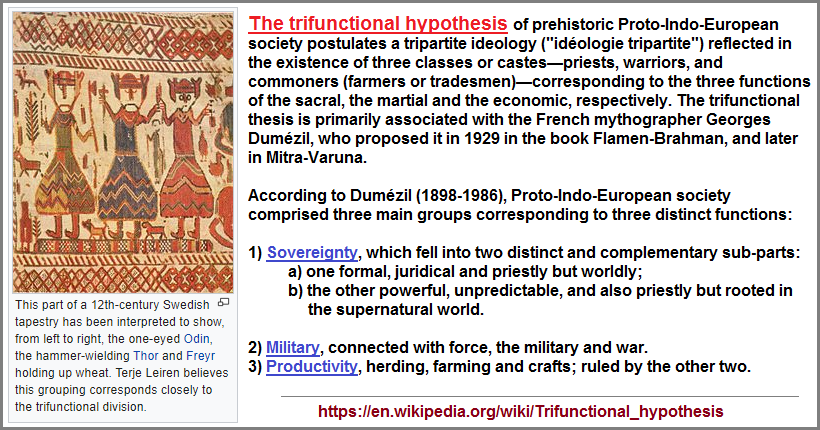
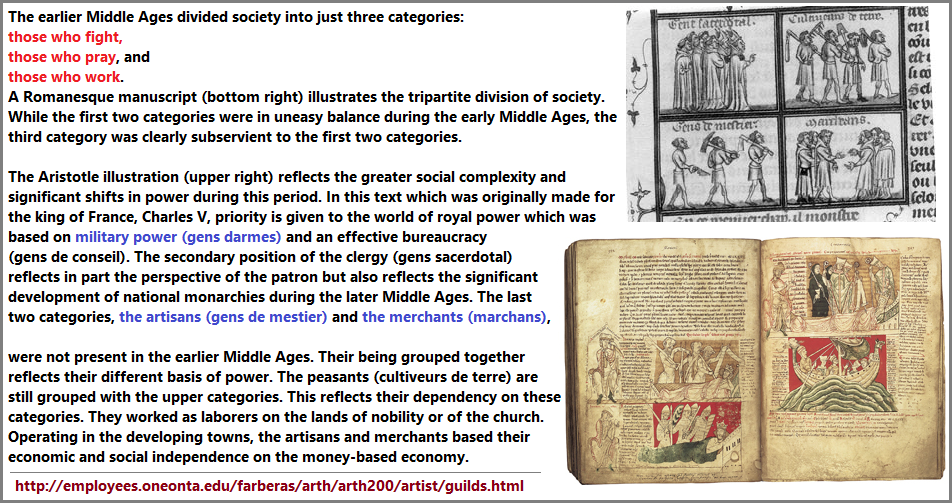
Date of (series) Origination: Friday, 30th July, 2021... 6:38 AM
Date of (this page's) Initial Posting: Thursday, 18th November, 2021... 10:27 AM